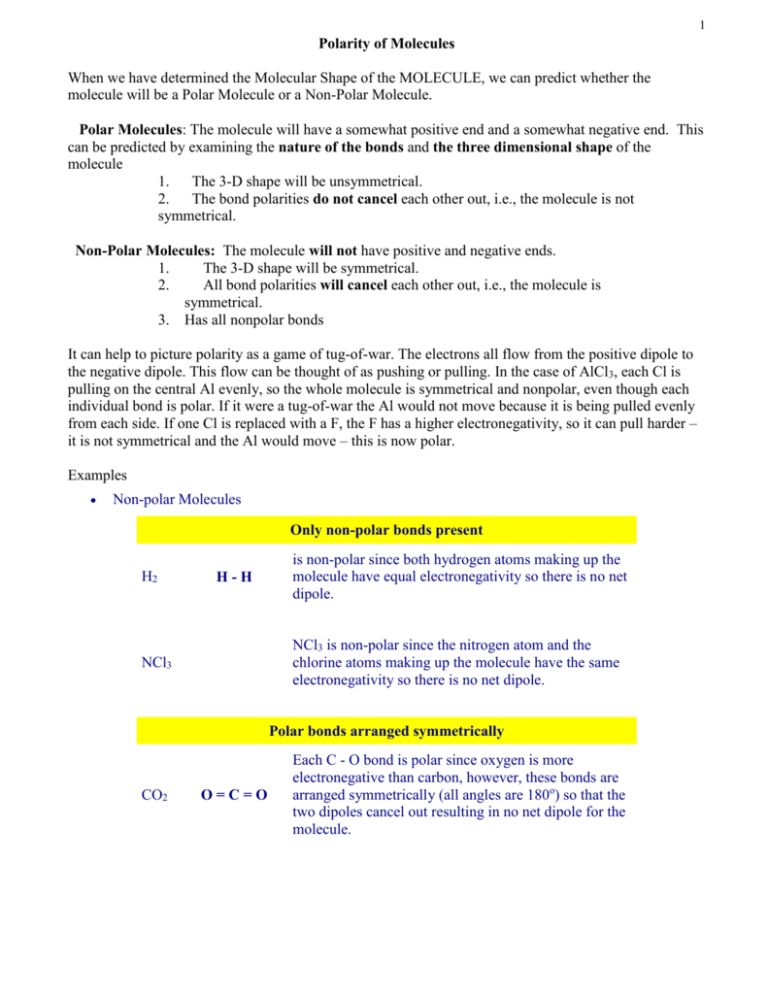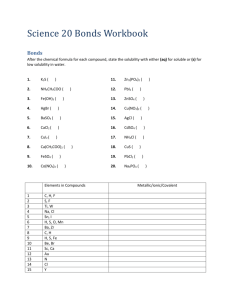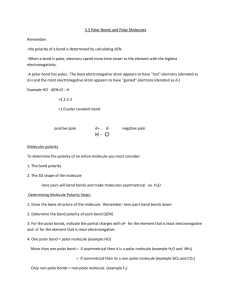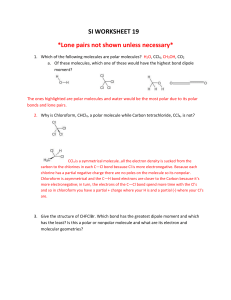Molecular Polarity Notes
advertisement

1 Polarity of Molecules When we have determined the Molecular Shape of the MOLECULE, we can predict whether the molecule will be a Polar Molecule or a Non-Polar Molecule. Polar Molecules: The molecule will have a somewhat positive end and a somewhat negative end. This can be predicted by examining the nature of the bonds and the three dimensional shape of the molecule 1. The 3-D shape will be unsymmetrical. 2. The bond polarities do not cancel each other out, i.e., the molecule is not symmetrical. Non-Polar Molecules: The molecule will not have positive and negative ends. 1. The 3-D shape will be symmetrical. 2. All bond polarities will cancel each other out, i.e., the molecule is symmetrical. 3. Has all nonpolar bonds It can help to picture polarity as a game of tug-of-war. The electrons all flow from the positive dipole to the negative dipole. This flow can be thought of as pushing or pulling. In the case of AlCl3, each Cl is pulling on the central Al evenly, so the whole molecule is symmetrical and nonpolar, even though each individual bond is polar. If it were a tug-of-war the Al would not move because it is being pulled evenly from each side. If one Cl is replaced with a F, the F has a higher electronegativity, so it can pull harder – it is not symmetrical and the Al would move – this is now polar. Examples Non-polar Molecules Only non-polar bonds present H2 H-H is non-polar since both hydrogen atoms making up the molecule have equal electronegativity so there is no net dipole. NCl3 is non-polar since the nitrogen atom and the chlorine atoms making up the molecule have the same electronegativity so there is no net dipole. NCl3 Polar bonds arranged symmetrically CO2 O=C=O Each C - O bond is polar since oxygen is more electronegative than carbon, however, these bonds are arranged symmetrically (all angles are 180o) so that the two dipoles cancel out resulting in no net dipole for the molecule. 2 AlCl3 Each Al-Cl bond is polar since chlorine is much more electronegative than aluminium, however, each Al-Cl bond in AlCl3 is arranged symmetrically (all angles are 120o) so that the dipoles cancel out resulting in no net dipole for the molecule. CH4 Each C-H bond is polar since carbon is more electronegative than hydrogen, however, each C-H bond in CH4 is arranged symmetrically (all angles are 109.5o) so that the dipoles cancel out resulting in no net dipole for the molecule. Polar Molecules Polar bonds arranged unsymmetrically HCN ----------> Both the C-H and the C-N bonds are polar. Nitrogen is more electronegative than carbon which is more electronegative than hydrogen. So that the hydrogen takes on a partial positive charge and the nitrogen takes on a partial negative charge. This results in an unequal sharing of the bonding electrons resulting in a net dipole for molecule since the two dipoles do not cancel out. H2O Each O-H bond is polar since oxygen is more electronegative than hydrogen so each hydrogen takes on a partial positive charge and the oxygen atom takes on a partial negative charge. The two O-H bonds are arranged unsymmetrically (angle between bonding pair < angle between bonding pair and lone pair < angle between lone pair and lone pair) resulting in a net dipole since the two dipoles do not cancel out. NH3 Each N-H bond is polar since nitrogen is more electronegative than hydrogen so each hydrogen takes on a partial positive charge and nitrogen takes on a partial negative charge. The three N-H bonds are arranged unsymmetrically (angle between bonding pairs < angle between bonding pairs and lone pair) resulting in a net dipole since the three dipoles do not cancel out. CH3Cl Each C-H bond is polar since carbon is more electronegative that hydrogen, and the C-Cl bond is polar since chlorine is more electronegative than either carbon or hydrogen. Each hydrogen atom will take on a partial positive charge and the chlorine atom will take on a partial negative charge resulting in a net dipole since the dipoles will not cancel out owing to the difference in electronegativities of carbon, hydrogen and chlorine. 3 Predicting Molecular Polarity Tip-off – You are asked to predict whether a molecule is polar or nonpolar; or you are asked a question that cannot be answered unless you know whether a molecule is polar or nonpolar. (For example, you are asked to predict the type of attraction holding the particles together in a given liquid or solid.) General Steps Step 1: Draw a reasonable Lewis structure for the substance. Step 2: Identify each bond as either polar or nonpolar. (If the difference in electronegativity for the atoms in a bond is greater than 0.4, we consider the bond polar. If the difference in electronegativity is less than 0.4, the bond is essentially nonpolar.) If there are no polar bonds, the molecule is nonpolar. If the molecule has polar bonds, move on to Step #3. Step 3: If there is only one central atom, examine the electron groups around it. If there are no lone pairs on the central atom, and if all the bonds to the central atom are the same, the molecule is nonpolar. (This shortcut is described more fully in the Example that follows.) If the central atom has at least one polar bond and if the groups bonded to the central atom are not all identical, the molecule is probably polar. Move on to Step #4. Step 4: Draw a geometric sketch of the molecule. Step 5: Determine the symmetry of the molecule using the following steps. Describe the polar bonds with arrows pointing toward the more electronegative element. Use the length of the arrow to show the relative polarities of the different bonds. (A greater difference in electronegativity suggests a more polar bond, which is described with a longer arrow.) Decide whether the arrangement of arrows is symmetrical or asymmetrical If the arrangement is symmetrical and the arrows are of equal length, the molecule is nonpolar. If the arrows are of different lengths, and if they do not balance each other, the molecule is polar. If the arrangement is asymmetrical, the molecule is polar. Predict whether or not the following molecules are polar or not: carbon tetrachloride, CH3Cl, silicon disulfide, C2H2, PH3, H2O








